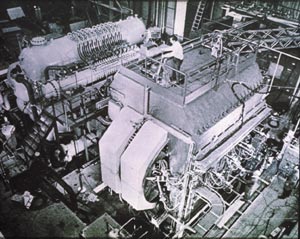
Leon Lederman, former director of Fermilab, once described the development of particle physics as frequently a story of false trails, crossed wires, sloppy techniques, misconceptions and misunderstandings, occasionally compensated for by strokes of incredible luck. Certainly, this subject is quite often a tale of the unexpected. Nowhere is this more true than for the subject of neutrino physics, and the elucidation of neutral weak currents.
Neutral currents were discovered in 1973 by a collaboration operating with the large heavy-liquid bubble chamber Gargamelle at the CERN proton synchrotron (PS). It was built by a team of physicists and engineers at Saclay, led by André Lagarrigue. Lagarrigue’s plans for Gargamelle were laid following the Siena Conference in 1963, where results were reported from the first PS neutrino experiments with the CERN 1.2 m heavy-liquid chamber, built by a team led by Colin Ramm.
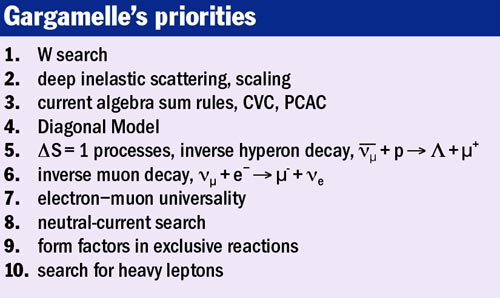
The results that were obtained from this small CERN chamber (Block et al. 1964) included a limit on the ratio of “elastic” neutral-current (NC) events to charged-current (CC) events: σ(νμ + p → νμ + p)/σ(νμ + n → μ– + p) < = 0.03 for events with proton momentum above 250 MeV/c. The accepted ratio is about 0.12. The CERN result was just wrong, following a book-keeping error (the actual 90% confidence limit was < 0.09). As is often the case in physics, the error was uncovered by a graduate student, Michel Paty from Strasbourg, who found a limit < = 0.20 and put this number in his thesis (Paty, 1965). The CERN group intended to publish an erratum, but (since there seemed to be little interest in our limit) we decided to wait for the results from a forthcoming propane run, since that would measure scattering from free as well as bound protons, and we could exploit the better kinematic constraints. However, the propane run was delayed by more than two years and the corrected limit for the ratio of < 0.12 ± 0.06 was not published until 1970 (Cundy et al. 1970).
Model behaviour

The Gargamelle collaboration on neutrino physics (Aachen, Brussels, CERN, Ecole Polytechnique, Milan, Orsay and UCL) had formed by 1968, and met in Milan to list the priorities in the forthcoming neutrino experiments (see “Gargamelle’s priorities”). The search for neutral currents was way down at number eight. And it has to be explained here that at that time there were several different models for beating the divergence problems of the Fermi theory, and neutral currents as postulated by the electroweak model of Glashow (1961), Salam (1968) and Weinberg (1967) was just one option. Other models included the “diagonal” model of Gell-Mann, Goldberger, Kroll and Low (1969). In this model, the divergence in non-diagonal processes involving unlike currents, such as in muon decay, were cancelled out, whereas for like currents such as in νe + e → νe + e–, the expected cross-sections could be arbitrarily large. We knew that there was support for this model from a reactor experiment by Reines and Gurr (1970), who initially found a cross-section for this process of more than 100 times the V-A value (which turned out to be yet one more of the many wrong numbers floating around in the neutrino field, although we did not know that at the time). In the 1970 paper of Cundy et al. giving the revised value for the NC:CC ratio, the limit on diagonal coupling was in fact given pride of place above that for neutral currents.

The situation changed dramatically in 1971, following the work on renormalization by Veltman and ‘t Hooft, showing that for the electroweak model, the cross-sections were finite and clearly specified in terms of just one unknown parameter, sin2θw. But it is necessary to emphasize here that the ‘t Hooft paper was – like the other papers on the electroweak model – about the interactions between leptons. It was not clear then how hadrons might be incorporated into the model, and there could be unknown suppression effects, as in the Cabibbo theory. So, many people in the Gargamelle group felt that emphasis should be first of all on a search for the very rare leptonic processes νμbar + e– → νμbar + e– and νμ + e– → νμ + e– where a single electron is projected at a small forward angle (about 2 degrees) to the beam at giga-electron-volt energies. The antineutrino process was preferred since the principal background from νe + n → e– + p was expected to be less than 1%. In a 1.4 million picture antineutrino run, between 5 and 30 antineutrino events were expected, depending on the weak mixing angle. In fact, it turned out that the actual value of sin2θw = 0.23 meant that the number of events was near the minimum: after a cut of E > 0.3 GeV on electron recoil energy and the effect of finite scanning efficiency, only three events were found. But they were gold-plated, unmistakable events, of which the first was found at Aachen in December 1972.
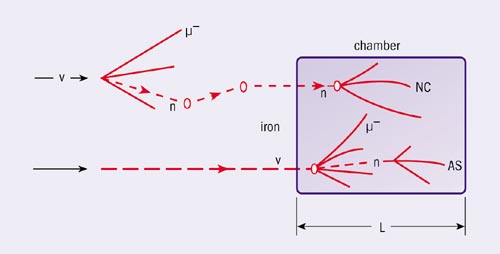
A stroke of luck
Here we had some real luck. This first event (Hasert et al. 1973) was initially recorded by a scanner, who put it down as a “muon plus gamma ray”. But a sharp-eyed graduate student, Franz-Josef Hasert, realized that it must be something else, and showed it to Prof. Helmut Faissner, who recognized it immediately for what it was. Faissner showed me this event at New Year 1973, and since at that time the expected background in the 100,000 pictures scanned to date was < 0.01 events, I was convinced that this was a real signal and that neutral currents really existed. I would have been less sanguine had I known that, in scanning 14 times as much film over the next year – and accumulating 14 times as much background – only two further events were to be found. Of course, three events could hardly establish a new physical process, but the important thing was that this first observation of a leptonic neutral-current event gave great encouragement to the collaboration to push ahead further with the search for hadronic neutral currents.
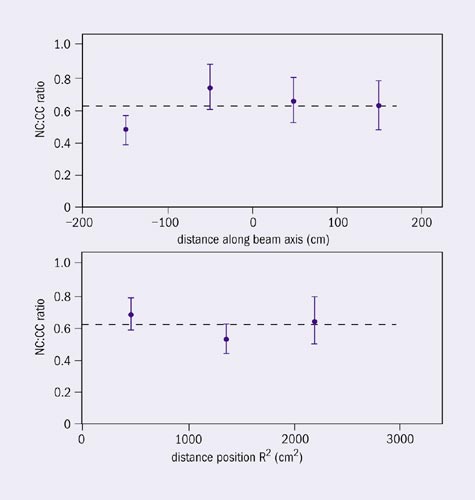
The establishment of a neutral-current signal for events containing only hadron secondaries and no muon was a more complex story. Since the neutrino cross-sections on nucleons were more than two orders of magnitude bigger than those on electrons, a clear understanding of the background, rather than of statistics, was the main problem. The first step for the Gargamelle collaboration was to resolve to look for inclusive events of the type ν + N → ν + hadrons, rather than exclusive processes, which would be more difficult to identify, and to select only the highest-energy events, with total hadronic energy E > 1 GeV.
Events with identified hadrons only were called “NC”, for neutral-current candidates, as compared with charged-current (“CC”) events containing a charged lepton (muon). “AS” events were those in which a CC event had an associated “star” due to a secondary neutron in the same picture (figure 1). Suppose that a number B of the NC events are due to neutrons, then if we take a simple one-dimensional model with all particles travelling along the beam and chamber axis, the expected value of B can be easily calculated from the number of AS events in “equation 1”, where L = 600 g cm-2 is the fiducial length of the chamber, λ = 135 g cm-2 is the neutron interaction length in the liquid and λatt ~ 300 g cm-2 is the attenuation length of neutrons in the shield – that is, the distance over which the number of neutrons of a particular energy is reduced by a factor e. This attenuation length was calculated from the shape of the neutron energy spectrum measured in AS events and reasonable assumptions on the elasticity ε of neutron interactions. In fact for a power-law neutron spectrum of the form dN/dE ~ E-n, the attenuation length is simply λatt =λ/[1-<εsup>n-1>] (and typically n ~ 2 and ε ~ 1/2).
Clearly the B:AS ratio simply states that for L » λ, the neutrons entering the front of the chamber are generated by neutrino interactions from an upstream region in the shield of thickness λatt, while inside the chamber the AS neutron stars can be generated by neutrino interactions anywhere inside a distance L, less an amount λ for neutron detection. By using this equation, one calculated B/AS = 0.7, compared with the observed ratio of NC/AS ~ 6.0. This implied that only about 10% of the NC events were due to neutrons. A full Monte-Carlo simulation by Fry and Haidt (Fry and Haidt 1975) using detailed data on the neutrino beam divergence, the angular and energy distribution of secondary neutrons and the elasticity distribution in the propagation of the neutron cascade in the shield gave essentially the same numbers. It happens that the simple one-dimensional approximation works because of the relatively high energy of the hadronic events, so that most of the neutrons do enter the front face of the chamber.
Confirmation that the NC events were produced by neutrinos came from measurement of the longitudinal and radial dependence of the NC:CC event ratio in the chamber (figure 2), which was found to be constant within the statistical errors, whereas a predominantly neutron origin would have shown strong dependence on longitudinal and/or radial distance.

A counter-experiment at Fermilab by the HPWF (Harvard, Pennsylvania, Wisconsin, Fermilab) group was contemporaneous with the Gargamelle experiment, and used a 300 GeV proton beam, compared with the 26 GeV beam from the CERN PS. The results from both Gargamelle (Hasert et al. 1973a, 1974) and HPWF were presented by Myatt at the Bonn Conference in August 1973, as positive evidence for neutral currents. Shortly afterwards, the HPWF result was withdrawn, following modifications to the experiment. Figure 3 shows a diagram of the HPWF set-up. It consisted of a liquid scintillator plus spark chamber detector acting as a target and as a hadron calorimeter, followed by a muon spectrometer containing magnetized iron toroids instrumented with spark chambers. A CC event would register as a hadron shower in the scintillator section, plus a muon penetrating through to the spectrometer, while a NC event would consist of a hadron shower only. From the angular distribution of the muons in the observed CC events, one could calculate the true muon angular distribution at production and hence the proportion of CC events appearing as NC “background” events because the muon missed the spectrometer. After making this correction, the ratio of rates as given at Bonn was found to be: HPWF (mixed ν/νbar beam) NC:CC = 0.29 ± 0.09…which was compatible with the Gargamelle results, as follows: Gargamelle ν beam NC:CC = 0.21 ± 0.03; Gargamelle νbar beam NC:CC = 0.45 ± 0.09.
Following the Bonn Conference, HPWF undertook a major re-configuration of the experiment to enhance the NC signal by reducing the correction for “lost” muons emitted at wide angles in CC events. The areas of the spark chambers in the muon spectrometer were increased, and a large spark chamber, SC4, originally part of the hadron calorimeter, was made part of the muon-detection system by placing a 30 cm thick steel plate in front of it. Previously the first muon chamber had been behind 1.25 m of steel. The reduced steel thickness in front of SC4 unfortunately led to a quite catastrophic increase in punch-through of energetic hadrons, and because of this genuine NC events would be wrongly classified as CC events. By November 1973 the modified HPWF ratio was quoted as NC:CC = 0.05 ± 0.05 – consistent with no neutral-current events at all. This incorrect result was primarily because the hadronic punch-through probability – and hence the proportion of genuine NC events misclassified as CC events – had been underestimated by more than a factor of two. The considerable uncertainties and errors in this experiment were eventually resolved and new values, with a horn-focused beam, were given in April 1974 as NC:CC (ν) = 0.11 ± 0.05: NC:CC (νbar) = 0.32 ± 0.09 (Benvenuti et al. 1974).

Impeded progress
However, the damage had been done, and after this debacle many physicists were quite unconvinced of the reality of neutral currents. It was to take another year from the time of the original Gargamelle claim before independent confirmation of their existence came from a bubble-chamber experiment at Argonne, counter-experiments at Brookhaven and a Caltech group in a narrowband beam at Fermilab, all reported at the London Conference in 1974.
In figure 4, the value of the ratio NC:CC for neutrinos is plotted against the value for antineutrinos for the Gargamelle and HPWF experiments, together with the (valence quark model) prediction from the electroweak theory as a function of the mixing parameter sin2θw. The Gargamelle value of 0.38 ± 0.09 was a long way from the accepted figure of 0.23. Probably the discrepancy was due to the strong minimum hadron energy cut of 1 GeV, and the inadequacy of the simple quark model at these relatively low neutrino energies for assessing such effects. It will also be seen that the HPWF result is inconsistent with the electroweak theory for any value of sin2θw. However, the main point is that both experiments had now found a clear neutral-current signal, regardless of whether it agreed with a particular model.

It is perhaps not generally realized today that the measurement at CERN of sin2θw in neutrino experiments has an interesting, and one might even say noble, history. Some of the main evidence at present for physics beyond the Standard Model comes from the detection of neutrino masses and neutrino oscillations, deduced from analysis of atmospheric neutrino interactions over the last few years. Yet a handful of atmospheric neutrino interactions were first recorded more than 40 years ago in deep mine experiments, and were at that time considered to be of little interest. The detection today of large numbers of such interactions in underground multi-kiloton detectors such as SuperKamiokande was originally quite unintentional. They occurred as an unwanted background to the main goal of finding proton decay. In turn, the proton-decay search had been triggered by the initial success of the minimal SU(5) version of GUTs, which arose largely because of wrong CERN results. The experiments in question were in the BEBC chamber with neon or hydrogen fillings in an SPS wideband neutrino beam. They found some anomalously low values for sin2θw and brought the world average down to 0.21, in keeping with the prediction of non-supersymmetric SU(5) (figure 5). This led to the consequent underground searches in three continents for proton decay as a unique test of grand unification. So even wrong experimental results can sometimes have unexpected but very significant and positive consequences.
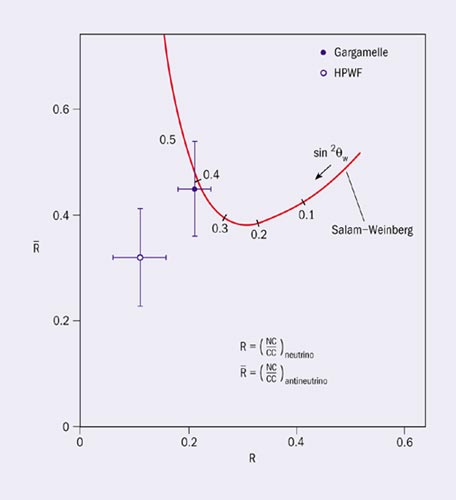
Finally let me say a few words about the role of Willi Jentschke in the neutral-current story. When the claim to have found neutral currents in Gargamelle was followed by the report from Fermilab that the NC:CC ratio they found was consistent with zero, many physicists in CERN and Europe – but not in the US – believed that the Gargamelle result must be wrong. Indeed, one senior CERN physicist bet so heavily against Gargamelle that he lost half his wine cellar. But Jentschke himself was always very supportive of the experiment. I myself never discussed it formally with him but I did meet him on one occasion in the CERN lift. He told me he was worried about the Gargamelle result, because some people had told him that it could be wrong. I replied that, of course, any experiment could be wrong. For example, looking back over the last 25 years, I had found that 85% of my previous experiments had been wrong.
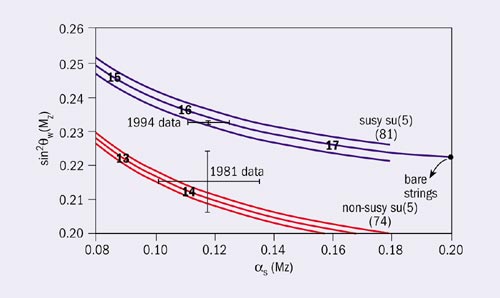
This seemed to shake him, and he told me that, if the Gargamelle result was wrong, it would be very bad for CERN. My response was that, coming after the “split A2” affair, it would be an absolute disaster. However, I knew the group had gone through the event analysis many times and for almost a year we had searched intensively for some other explanation for the effects observed, without success. So I thought the result was absolutely solid, and he should just ignore rumours from across the Atlantic. I don’t know if my words reassured him, but he got out of the lift with a smile on his face.
Further reading
A Benvenuti et al. 1974 Phys. Rev. Lett. 32 800.
M M Block et al. 1964 Phys. Lett. 12 281.
D C Cundy et al. 1970 Phys. Lett. 31B 478.
A Dimopoulos 1994 Proc. 28th Intl. Conf. on High Energy Phys.(Glasgow).
W F Fry and D Haidt CERN Report 75-1.
M Gell-Mann et al. 1969 Phys. Rev. 179 1518.
S L Glashow 1961 Nucl. Phys. 22 579.
F J Hasert et al. 1973 Phys. Lett. 46B 12 1.
F J Hasert et al. 1973a Phys. Lett. 46B 138.
F J Hasert et al. 1974 Phys. Lett. B73 1.
G ‘t Hooft 1971 Nucl. Phys. B33 173.
M Paty CERN Report 65-11.
F Reines and H S Gurr 1970 Phys. Rev. Lett. 24 1448.
A Salam 1968 in Elementary Particle Theory ed. N Svartholm (Almqvist and Wiksell, Stockholm).
S Weinberg 1967 Phys. Rev. Lett. 19 52 1.





